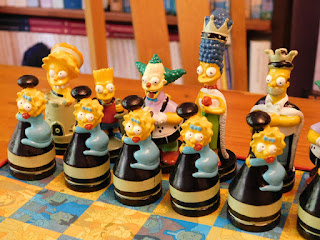Tamerlane Chess, aka Timur's chess, is a chess variant dating back to 14th century Persia. It has more different pieces than
FIDE chess, and each pawn is linked to a particular major piece (and can only promote to that piece). To accommodate the higher number of pieces, the board is 10x11, and has, in addition, two citadels. These citadels are basically escape squares: if a king reaches the opposite citadel, the game is drawn. Full rules can be found
here, and the initial set-up looks like this:
When we went
collecting shells for
my first commission of making a chess set, we collected many more shells than I needed in the end. As I always wanted to make a set for Tamerlane Chess, it made sense to use the remaining shells for that (plus that sea shells are very good for making chess sets!).
I decided to make the board not square, but have the sides slightly slanted to include the citadels.

The squares were to be made from mother-of-pearl tiles and I do feel the board came out very striking.


Then on to the pieces! I had a lot of fun thinking through their design, and deciding which shells to use for which piece. Here are pictures of all pieces, with their associated pawns, both 'raw' and painted. The pawns are all made using limpet shells, and for each pawn, I've taken a small version of the (main) shell used for the major piece as an identifying trait. The only exception to this is the 'pawn of pawns', the only pawn not linked to a major piece (its promotion rules are quite complex, too complex to discuss here).

Dabbaba (war engine), using surf clams

Jamal (camel), using scallop shells

Pil (elephant), using whelks

Rukh (chariot aka rook), using slipper shells

Faras (horse aka knight), using mussels

Talia (vanguard), using various snail shells

Zurafa (giraffe), using razor shells

Wazir (vizier), using sepia shields and cowries

Ferz (general), using piddocks

And finally, the shah (king), using oysters and (fake) pearls. This piece being the king, the pearl is the only part of any piece that's not painted.

And here's what the set looks like with all the pieces on their starting squares.


Several set-ups and variants (e.g. a
'Full' Tamerlane chess, with additional pieces) are known from various literary sources. The set-up used above is the common 'masculine' set up; as you might expect from the name, there is also a 'feminine' set up. This 'feminine' set-up uses the same pieces as the common 'masculine' set-up, but with some of the pieces in the centre on different starting squares.
I must say I'm
really pleased with how my Tamerlane Chess set turned out ...





















































